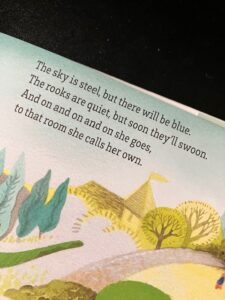You might have heard this advice before; I know I have. A quick search on the internet finds lots of similar examples…
“Tips for writing picture books: don’t write in rhyme.”
“The editor loved the concept, but was not drawn to the rhyme.”
I admit it—I love rhyme! But I also try to challenge myself to utilize other tools in my poet’s toolbox, too:
repetition, rhythm, assonance, consonance, alliteration, and more.
I recently happened upon a wonderful example of a poetic, lyrical picture book text: A ROOM OF YOUR OWN: A STORY INSPIRED BY VIRGINIA WOOLF’S FAMOUS ESSAY by Beth Kephart, illustrated by Julia Breckenreid (Cameron Kids, 2022).
First, the concept is brilliant: talking about having a room of one’s own in which to dream and create, and then encouraging children to think about where their “room” might be, their place “to think, to dream, to be.”
Could it be under a table, in a hayloft, up a tree, or on a cool city stoop?
Second, the narrative is lyrical, poetic, and a beautiful example of a text that does not rely on rhyme yet is packed with so many other poetic elements. I now have it on my shelf to boost my creativity when I find myself leaning too heavily on rhyme!
I hope it inspires you, too, and that you have some sweet summer days ahead of you in a room of your own.
On Fridays, I love taking part in Poetry Friday when I can, where writers share resources about children’s poetry. This week, Mary Lee Hahn hosts the Poetry Friday Roundup today at her blog. Check out the celebration of poetry there today!




Good advice and great examples! Plus, how fun to bring Virginia Woolf to young readers in a way they can access!
Great advice and I love the example, Mary! It’s a book new to me and I will look for it! It reminds me of my younger granddaughter who spent a great deal of her time during the pandemic under their dining table-her ‘room’! ~ Linda B
What a lovely example of a room of one’s own, Linda. I love when children take matters into their own hands!
It’s truly a delightful book. Thanks, Mary Lee!
Great advice and I love the example, Mary! It’s a book new to me and I will look for it! It reminds me of my younger granddaughter who spent a great deal of her time during the pandemic under their dining table-her ‘room’! ~ Linda B
Oh, I’ve heard this before, too! And it’s amazing how many books rhyme, but don’t have rhythm! As a children’s librarian who does story times, I always implore authors to read their texts aloud and listen for the rhythm – because when a text doesn’t flow, it can make for a tongue-twister of a story time! 😉
That is so true, Jane– reading it aloud!Thank you.
For some reason, the images wouldn’t show when I opened your post. But you’ve intrigued me enough with the title and review, so I’ll hunt this one down at the library next week! Thank you!
Thanks, Patricia!
Thanks for the book recommendation, Mary. I’ve added it to my tbr shelf. Also, the images don’t show up for me, but if I click on the empty white rectangles, then I can see them…
Hmmm, I will look into that, Laura. Thank you!
Great tips! Yes, I am inspired…thank you!
I’m so glad, Linda!
I am inspired! Looks like a terrific book to have on hand.
Jane is so right about making sure that a manuscript reads well aloud.
Thanks, Mary!
I’m glad to share a new source of inspiration, Tabatha!
Oh! I don’t think I’ve read this book. Off to see if my library has it!
I think you’ll love it, Marcie!
Thanks, Mary–this book was not on my radar. I notice in your samples that Beth Gephart definitely relies on assonance if not full rhyme–always a good way to go.